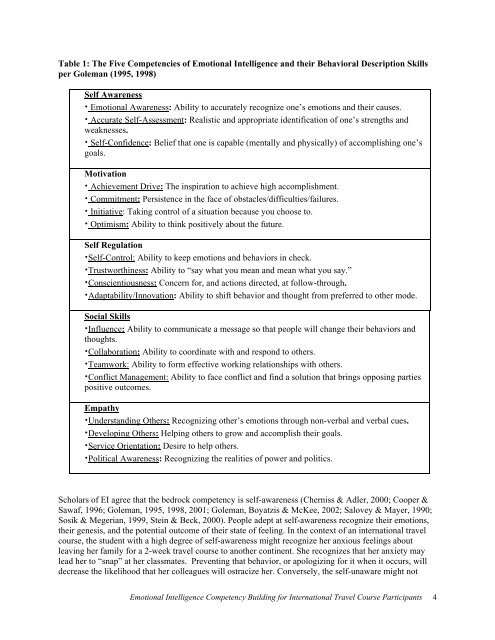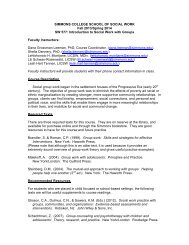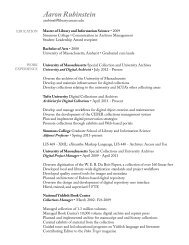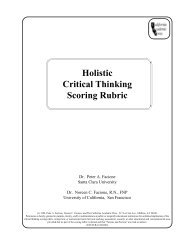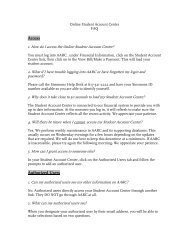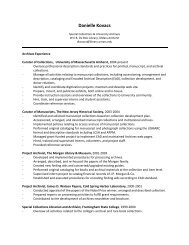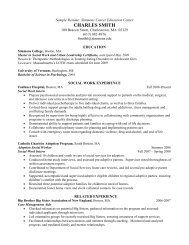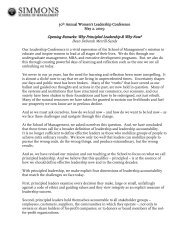Incorporating Emotional Intelligence into the Preparation and ...
Incorporating Emotional Intelligence into the Preparation and ...
Incorporating Emotional Intelligence into the Preparation and ...
You also want an ePaper? Increase the reach of your titles
YUMPU automatically turns print PDFs into web optimized ePapers that Google loves.
Table 1: The Five Competencies of <strong>Emotional</strong> <strong>Intelligence</strong> <strong>and</strong> <strong>the</strong>ir Behavioral Description Skillsper Goleman (1995, 1998)Self Awareness• <strong>Emotional</strong> Awareness: Ability to accurately recognize one’s emotions <strong>and</strong> <strong>the</strong>ir causes.• Accurate Self-Assessment: Realistic <strong>and</strong> appropriate identification of one’s strengths <strong>and</strong>weaknesses.• Self-Confidence: Belief that one is capable (mentally <strong>and</strong> physically) of accomplishing one’sgoals.Motivation• Achievement Drive: The inspiration to achieve high accomplishment.• Commitment: Persistence in <strong>the</strong> face of obstacles/difficulties/failures.• Initiative: Taking control of a situation because you choose to.• Optimism: Ability to think positively about <strong>the</strong> future.Self Regulation•Self-Control: Ability to keep emotions <strong>and</strong> behaviors in check.•Trustworthiness: Ability to “say what you mean <strong>and</strong> mean what you say.”•Conscientiousness: Concern for, <strong>and</strong> actions directed, at follow-through.•Adaptability/Innovation: Ability to shift behavior <strong>and</strong> thought from preferred to o<strong>the</strong>r mode.Social Skills•Influence: Ability to communicate a message so that people will change <strong>the</strong>ir behaviors <strong>and</strong>thoughts.•Collaboration: Ability to coordinate with <strong>and</strong> respond to o<strong>the</strong>rs.•Teamwork: Ability to form effective working relationships with o<strong>the</strong>rs.•Conflict Management: Ability to face conflict <strong>and</strong> find a solution that brings opposing partiespositive outcomes.Empathy•Underst<strong>and</strong>ing O<strong>the</strong>rs: Recognizing o<strong>the</strong>r’s emotions through non-verbal <strong>and</strong> verbal cues.•Developing O<strong>the</strong>rs: Helping o<strong>the</strong>rs to grow <strong>and</strong> accomplish <strong>the</strong>ir goals.•Service Orientation: Desire to help o<strong>the</strong>rs.•Political Awareness: Recognizing <strong>the</strong> realities of power <strong>and</strong> politics.Scholars of EI agree that <strong>the</strong> bedrock competency is self-awareness (Cherniss & Adler, 2000; Cooper &Sawaf, 1996; Goleman, 1995, 1998, 2001; Goleman, Boyatzis & McKee, 2002; Salovey & Mayer, 1990;Sosik & Megerian, 1999, Stein & Beck, 2000). People adept at self-awareness recognize <strong>the</strong>ir emotions,<strong>the</strong>ir genesis, <strong>and</strong> <strong>the</strong> potential outcome of <strong>the</strong>ir state of feeling. In <strong>the</strong> context of an international travelcourse, <strong>the</strong> student with a high degree of self-awareness might recognize her anxious feelings aboutleaving her family for a 2-week travel course to ano<strong>the</strong>r continent. She recognizes that her anxiety maylead her to “snap” at her classmates. Preventing that behavior, or apologizing for it when it occurs, willdecrease <strong>the</strong> likelihood that her colleagues will ostracize her. Conversely, <strong>the</strong> self-unaware might not<strong>Emotional</strong> <strong>Intelligence</strong> Competency Building for International Travel Course Participants 4


